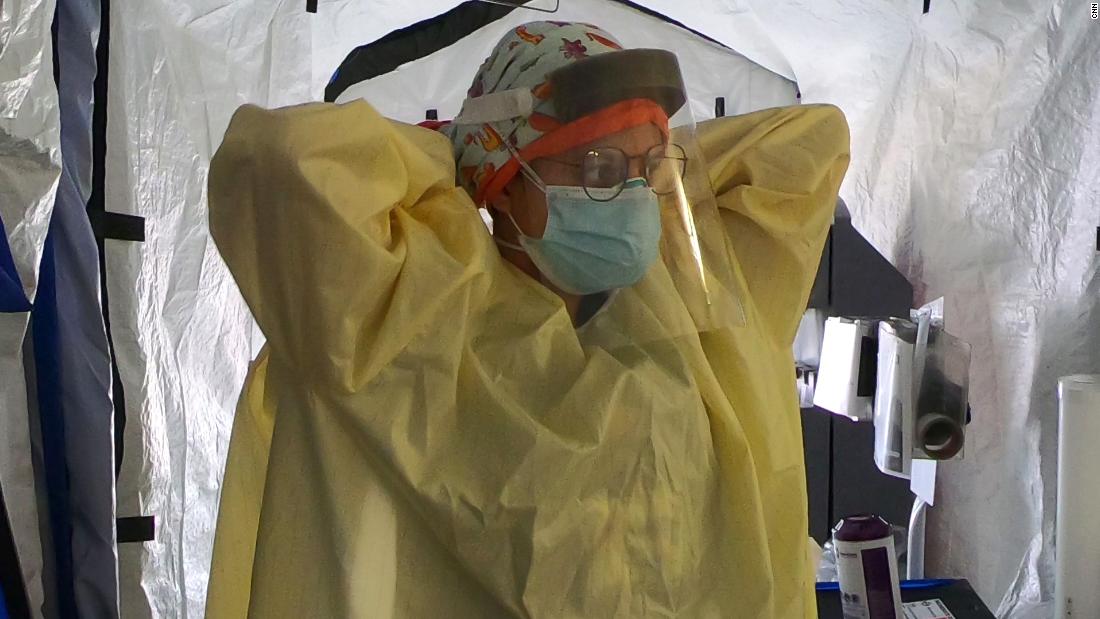Coronavirus has infected nearly every patient in this California town’s hospital, and more keep coming. Workers are exhausted, but the virus is not.
It’s loud inside the large blue tent at El Centro Regional Medical Center. Cooled air is blasting through two giant vents to counter the summer heat. Nurses half yell instructions in English and Spanish through their N95 masks and face shields to be heard by patients and each other.
The tents fill half the parking lot at the hospital — the most visible sign of the uncontrolled spread of Covid-19 in Imperial County in the far southeast of California, bordering Arizona and Mexico. The death rate here is the highest in the state.
Hospital CEO Adolphe Edward watches as people suspected of having coronavirus are assessed outside his 161-bed hospital, where he says nearly 90% of patients have tested positive for Covid.
Edward last saw these medical tents deployed in the Iraq War, during his 22-year service in the Air Force. He didn’t imagine erecting them on US soil but turned to them as coronavirus forced him to burst beyond the walls of his hospital.

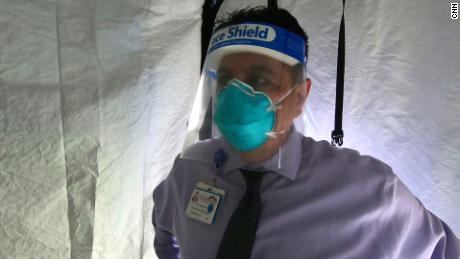
Adolphe Edward, CEO of El Centro Regional Medical Center, saw medical tents deployed in Iraq and now at home.
“We’re not used to seeing tents outside of hospitals,” says Edward. “When folks say it’s a war zone, well, a war zone of what? A war zone of us trying to combat Covid-19.”
Hot, exhausting work to save lives
The front line in the Covid war in Imperial County begins with the first responders.
At 11 a.m., as temperatures climbed to 110 degrees Fahrenheit, an emergency call sent El Centro Fire Department Captain Chad Whitlock to the front lawn of a home. Whitlock zipped up his bright yellow Tyvek suit, equipped with what looks like a scuba mask attached to an air pump. It’s called a powered air purifying respirator, or PAPR, pushing clean filtered air into Whitlock’s suit.

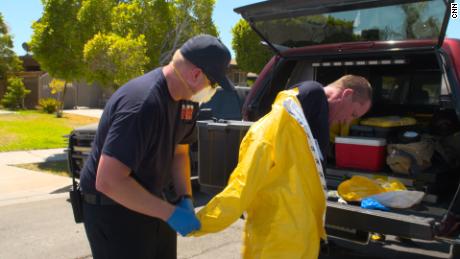
El Centro Fire Department Captain Chad Whitlock is helped out of his protective gear after helping a patient.
Whitlock approached a man, suspected of having Covid, passed out underneath a tree. He manages to revive him and an ambulance with a gurney arrives to take him away.
The patient Whitlock revived is heading to El Centro Regional Medical Center.
“We feel like we’re overwhelmed with so many patients,” says El Centro Regional nurse Stephen Jaime. “They’re just so sick.”

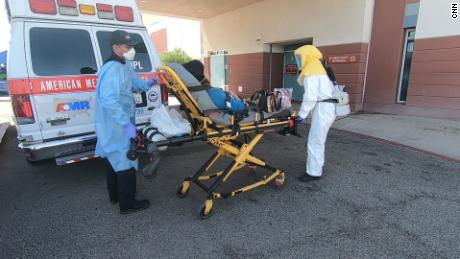
Another patient arrives at El Centro Regional Medical Center, where the ICUs are already full.
Eleven of the 12 Covid patients in this wing of the ICU are on ventilators and the medics are doing what they can to keep the 12th breathing on his own. More critically ill patients are in an 8-bed unit newly equipped as another Covid ICU. Nurses like Jaime move back and forth between the sealed rooms, putting on similar PAPR equipment to that worn by Whitlock on the emergency call.
Why it’s so bad in Imperial County
Imperial County has seen far more coronavirus infections, hospitalizations and deaths than its size warrants. Data from Johns Hopkins University shows the county has three times the number of infections per capita than Los Angeles. And its Covid death rate is nearly twice that of any other California county.
One in four people in El Centro live below the poverty line, and unemployment rates have steadily been way above the rest of the country, according to El Centro Mayor Efrain Silva.

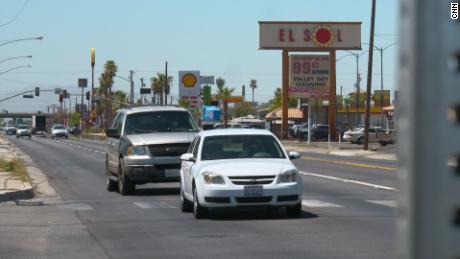
El Centro has high rates of pollution that contributed to cases of asthma and respiratory illness long before the pandemic.
That has contributed to abnormally high rates of asthma and respiratory illness, says Larry Lewis, CEO at Imperial County’s other community hospital, Pioneers Memorial Healthcare District.
Also prevalent in the county, says Lewis, is diabetes and obesity, all of which make coronavirus more severe. “When you hear about those who are more seriously impacted by the disease, ask a few follow up questions about their comorbidities,” Lewis said. “You’ll hear a constant theme that there are other things going on.”
Harvesting in a pandemic
And none of that has stopped the daily interaction between the border communities. More than 275,000 American citizens, including 30,000 military veterans, and thousands more green card holders live in Mexicali, according to Edward. And many choose his El Centro Regional Medical Center for care, he said. And many Mexicans come to work in Imperial County.
Every morning, as he has done for 45 years, Jacinto Moreno leaves his multigenerational home in Mexicali and walks through the Calexico border tunnel, legally. By 5:30 a.m., he’s starting his day at Duncan Family Farms.
Moreno, 65, tends to the all-organic fields that grow cilantro, romaine hearts, gold beets and swiss chard that not only fill the bins and shelves of grocery stores across the US and Canada, but also cross the Atlantic and end up in the kitchens of consumers in the UK.

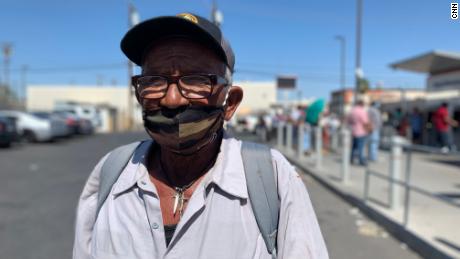
Jacinto Moreno has crossed the border almost daily for 45 years to work in the fields of Imperial County, he says.
He is one of at least 20,000 laborers who make the cross-border trek to make a living each day, chasing jobs that change with the season. They work even in a pandemic, though before Covid, that number was more like 50,000, according to El Centro city officials.
“That’s why in my backpack each day I bring gloves, face masks — I bring extra face masks,” Moreno says, pointing to the camo-print cloth covering only his mouth. The poorly placed cloth is just one indication of the lack of access to information Moreno and the other workers have about Covid.
The working conditions at the farm aren’t bad, he says, and the owners have been taking every precaution to avoid an outbreak. He’s learned to wipe down his hands to his boots with disinfectant, hoping it will keep him and his family free from the virus. He’s lost at least four of his fellow farm workers to coronavirus, but personally, Moreno believes he’s safe, having withstood adversity throughout his decades of migrant work.
“I take lots of vitamins, and look at me,” he says pounding his chest. “They say to stay inside but that’s worse, because you don’t sweat and that cleans your body.”
Misinformation among workers is rampant, says Olmedo, the local justice worker, who warns the virus knows no borders. To protect Americans, everyone needs to be helped to contain the spread.
“We must first deal with the inequities,” says Olmedo. “We cannot win a war on Covid in the emergency room.”
Preparing the last defense
Lewis, the CEO of Pioneers Memorial, says he’s trying to find more capacity for the ever-growing number of patients. “Today we’re in a good position to face the next month, but I worry about this extending for a year.”
He’s trying to rely on his own resources, fearing that the increase in coronavirus cases across California will mean that transferring patients to other hospitals will become harder.

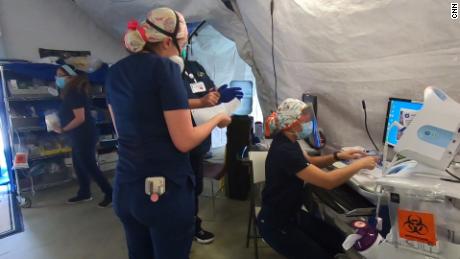
If needed, medics at El Centro are prepared to set up more ICU beds in a tent outside the hospital.
At El Centro Regional, the transfers have been happening daily, as bed space disappears. “In the last 2 to 3 months we’ve sent out something like 500 patients which is much, much higher than normal,” says Dr. Andrew LaFree, Medical Director of El Centro Regional’s ER. The hospital says patients have transferred to San Diego, a two hour drive, as well as to Northern California.
His hospital chief, Edward, wrote to California Sens. Dianne Feinstein and Kamala Harris, as well as every other representative in his region and state, begging for resources to cope with the “non-stop increase in cases.” He asked for funding for programs servicing low-income communities like Imperial County, as well as 28 ICU nurses, 14 respiratory therapists and 20 ventilators, saying the need was “urgent.”
He told CNN he is close to his last defense in his war with Covid. He has one more tent. Right now, the unused beds and folding chairs are still covered in plastic wrap. But it won’t be pristine for much longer. It is the future Covid ward.

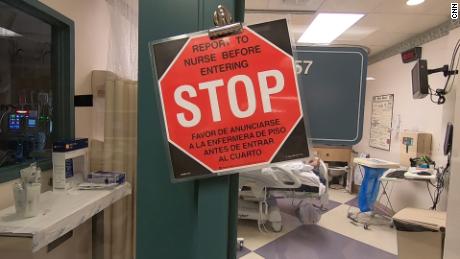
Imperial County is the worst affected county in California.
A week or so after each major holiday this year — whether it’s been Mother’s Day or Memorial Day — El Centro has seen a bump in cases, Edward says. And it’s now almost a week since July 4.
“I keep telling people now it’s a pandemic, eventually it’s going to be an endemic,” he adds. “Is this really how we want to take care of our communities? The answer is no.”
![]()


